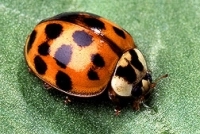|

By Chris Tramel
It’s that time of year again. A time when the air grows cooler, the leaves begin to turn, and families start preparing their homes for the cold winter months. But, it’s also a time when homes all across the South face an invasion from an occupying army, an army that, if not addressed early, will enjoy the warmth of your home throughout the winter. Even though you may not see them now, the dreaded Asian ladybug is preparing a takeover.
 The Asian ladybug, or ladybeetle, is very familiar to southerners during the winter months. It is then that the insects, which range from orange-brown to red in color, can be seen congregating on the south and southwest sides of houses and buildings. Unlike domestic ladybugs, which find outdoor shelter to weather the cold, the Asian imports seek buildings, usually light or white in color, where they can hibernate. Eventually the Asian ladybugs make their way, by the droves, through cracks and crevices to the warmth inside, usually to the displeasure of the homeowner. The Asian ladybug, or ladybeetle, is very familiar to southerners during the winter months. It is then that the insects, which range from orange-brown to red in color, can be seen congregating on the south and southwest sides of houses and buildings. Unlike domestic ladybugs, which find outdoor shelter to weather the cold, the Asian imports seek buildings, usually light or white in color, where they can hibernate. Eventually the Asian ladybugs make their way, by the droves, through cracks and crevices to the warmth inside, usually to the displeasure of the homeowner.
A native to Asia, the insect was introduced into the United States by both intentional and unintentional means. In an effort to control tree-feeding aphids and scale insects, the Federal government released the species, at various times, from the early 1900’s through to the 1980’s. The ladybug was also reported to have accidentally hitched a ride on cargo ships from time to time, infesting port areas like New Orleans.
The insects are for the most part very beneficial, consuming other pests that feed on gardens and landscapes. But anyone who has discovered two or three crawling around on their dinner plate, or found them crunching under their feet while walking in their own home, disagree.
While some experts would not classify them as pests, most homeowners who have to put up with the creatures every year rank the Asian ladybug in the same class as ants and termites. In addition to practically overtaking the interior of homes, the bugs will defend themselves by secreting their own blood. The blood emits a foul odor that is meant to ward off attackers, however to homeowners the secretion stains walls, curtains and carpet.
Ladybugs have also been known to pinch. Though not aggressive to people, the bugs occasionally test new environments by nipping at the skin. The bites are not anything more than a pinch, never breaking the skin, though they can be an annoyance to any unsuspecting victim. Other human interaction can be a little more serious, and sometimes painful, with some reports of allergic reactions to the invaders. Some people with inhalant allergies are affected, while others report skin reactions. The secreted blood from the insects can cause a stinging sensation to those with sensitive skin allergies.
 With the upcoming cooler weather, those wishing to avoid hosting a few thousand unwelcome houseguests should act soon. Experts say that once you see the ladybugs inside your home it’s too late. The insects like to hibernate inside walls, attics and crawlspaces, making them extremely hard to control. The best way to stop an infestation is to prevent it from happening in the first place. With the upcoming cooler weather, those wishing to avoid hosting a few thousand unwelcome houseguests should act soon. Experts say that once you see the ladybugs inside your home it’s too late. The insects like to hibernate inside walls, attics and crawlspaces, making them extremely hard to control. The best way to stop an infestation is to prevent it from happening in the first place.
One of the best prevention methods is to winterize your home. Seal up any cracks, holes, and spaces between windows and doorjambs, anywhere the ladybugs can creep into the house. The winterizing not only prevents the insects from entering the home; it also keeps helps with heating and cooling by providing better insulation. While this method can be effective, it can also be very expensive, especially for older homes.
Another preventative technique is the use of pesticides to the outdoors of the home. A variety of pesticides are available, but as always safety should be a priority. They should be used only as directed. Siding, eaves, windows, doorways, and anywhere the bugs can get into the home should be sprayed, but only to the home. Spraying landscaping and lawns are ineffective since during warm weather the bugs gather in trees and heavy vegetation.
The key to ladybug prevention is timing. To spray too early will degrade the insecticide before the bugs make their move to the home. To spray too late will allow the insects to gain a foothold inside the house. Prevention methods need to take place before the first cold snap of the season.
Once inside the home the most effective method of gathering the unwanted guest is by using a vacuum cleaner. Squashing the bugs will only cause staining on furniture and walls. Experts say the use of insecticides and foggers are usually ineffective because the ladybugs gather inside walls and attics where sprays cannot reach.
One thing is for sure, whether you like it or not, the Asian ladybug is here to stay. Your only choice is to take preventative measures or learn to love them.
|

